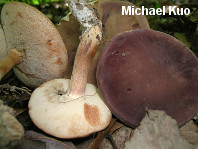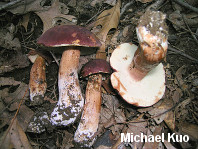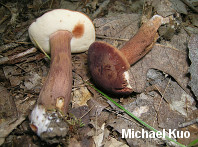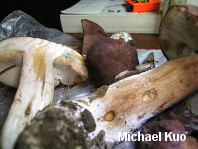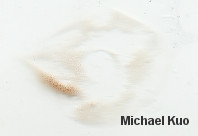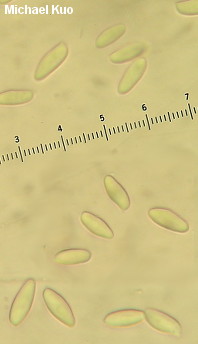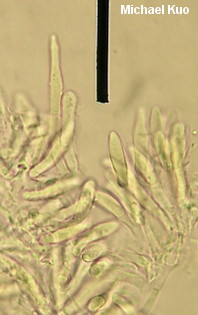| Major Groups > Boletes > Tylopilus > Tylopilus badiceps |

|
Tylopilus badiceps [ Basidiomycota > Boletales > Boletaceae > Tylopilus . . . ] by Michael Kuo Under current (and possibly outdated) concepts the name Tylopilus badiceps applies to eastern North American Tylopilus collections that share the following features:
If you have matched all the naked-eye features above except for the purple-brown color and your mushroom is merely "brown" or "reddish brown," I suggest calling it Tylopilus ferrugineus—but if you have a brown-capped, similar Tylopilus with a whitish stem (before it discolors when you handle it), see Tylopilus indecisus. Both of these look-alikes, however, have longer spores that often exceed 11 µ, so they are easily separated with a microscope. Charles Peck, who first described Tylopilus badiceps (1900), considered the "truncate or beveled margin of the pileus" to be an important feature of the species—but the folded-over cap edge is not always present; in my experience it is there only about half the time, and Tylopilus ferrugineus is equally capable of demonstrating the feature. Smith and Thiers (1971) thought that the microscopic structure of the cap surface made Tylopilus badiceps "one of the most easily recognized species in the genus." However, the structure they noted (a trichoderm composed of cystidium-like elements) is more variable, in my experience, than Smith and Thiers thought it was; the trichoderm often collapses, and the terminal cells are often merely cylindric rather than cystidioid (and, the pileipellis of Tylopilus ferrugineus is not significantly different). Ultimately, Tylopilus badiceps and Tylopilus ferrugineus are best separated by their colors when fresh (maroon and reddish brown, respectively), their spores (see above), and, in my collecting experience at least, their habitat: while both are associated with oaks, Tylopilus badiceps is a woodland species, while Tylopilus ferrugineus is almost always found in grassy areas under oaks in lawns or parks. If all of this suggests to you the possibility that the two species are the same and that, for example, it gets more sun in urban, grassy areas and therefore has a different cap color . . . well, I'm not going to argue with you, much. Perhaps a mycologist somewhere will study this species group with contemporary methods and clear things up. Description: Ecology: Mycorrhizal with oaks; growing alone, scattered, or gregariously; summer and fall; widely distributed in eastern North America. The illustrated and described collections are from Illinois. Cap: 3–15 cm; convex, becoming broadly convex or nearly flat, but often with a distinctively folded or creased edge creating a flat-sided profile when viewed from the side; dry; finely velvety when young, becoming sub-velvety or nearly bald; maroon (dark purple-brown) when young, becoming dark reddish brown and eventually fading to pinkish brown or tan. Pore Surface: Ivory when young, becoming dingy pinkish tan with age; bruising brown; pores circular to subangular, 1–2 per mm; tubes to about 1 cm deep. Stem: 2–13 cm long; 1–4 cm thick; more or less equal, or somewhat swollen at the base; bald; not reticulate, or finely reticulate near the apex; brown, or colored like the cap--even when young; basal mycelium white. Flesh: White; slowly staining pinkish in places when sliced. Odor and Taste: Odor often sweet and thick; taste sweet. Chemical Reactions: Ammonia red to purplish red (darker when the cap is young and has more purple in it), or negative; negative on flesh. KOH grayish to blackish on cap; negative to orangish on flesh. Iron salts olive on cap; olive or bluish gray on flesh. Spore Print: Brownish pink. Microscopic Features: Spores 8–11 x 3–4 µm; subfusiform; smooth; yellowish in KOH. Hymenial cystidia subfusiform to fusoid-ventricose; golden in KOH; smooth. Pileipellis a collapsing trichoderm; golden in KOH; terminal cells ranging from cylindric with rounded apices to fusiform-cystidioid; 2.5–5 µm wide. REFERENCES: (Peck, 1900) Smith & Thiers, 1971. (Peck, 1900; Saccardo, 1902; Smith & Thiers, 1971; Smith, Smith & Weber, 1981; Phillips, 1991/2005; Both, 1993; Bessette, Roody & Bessette, 2000; Binion et al., 2008.) Herb. Kuo 08309709, 08280501, 06300707, 07050705, 07110804. This site contains no information about the edibility or toxicity of mushrooms. |
© MushroomExpert.Com |
|
Cite this page as: Kuo, M. (2016, April). Tylopilus badiceps. Retrieved from the MushroomExpert.Com Web site: http://www.mushroomexpert.com/tylopilus_badiceps.html |
